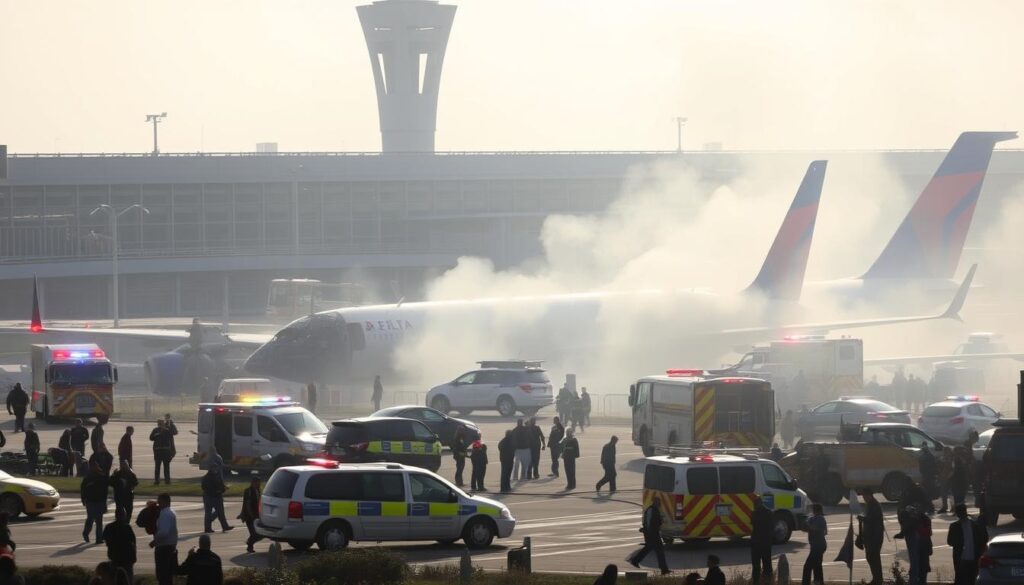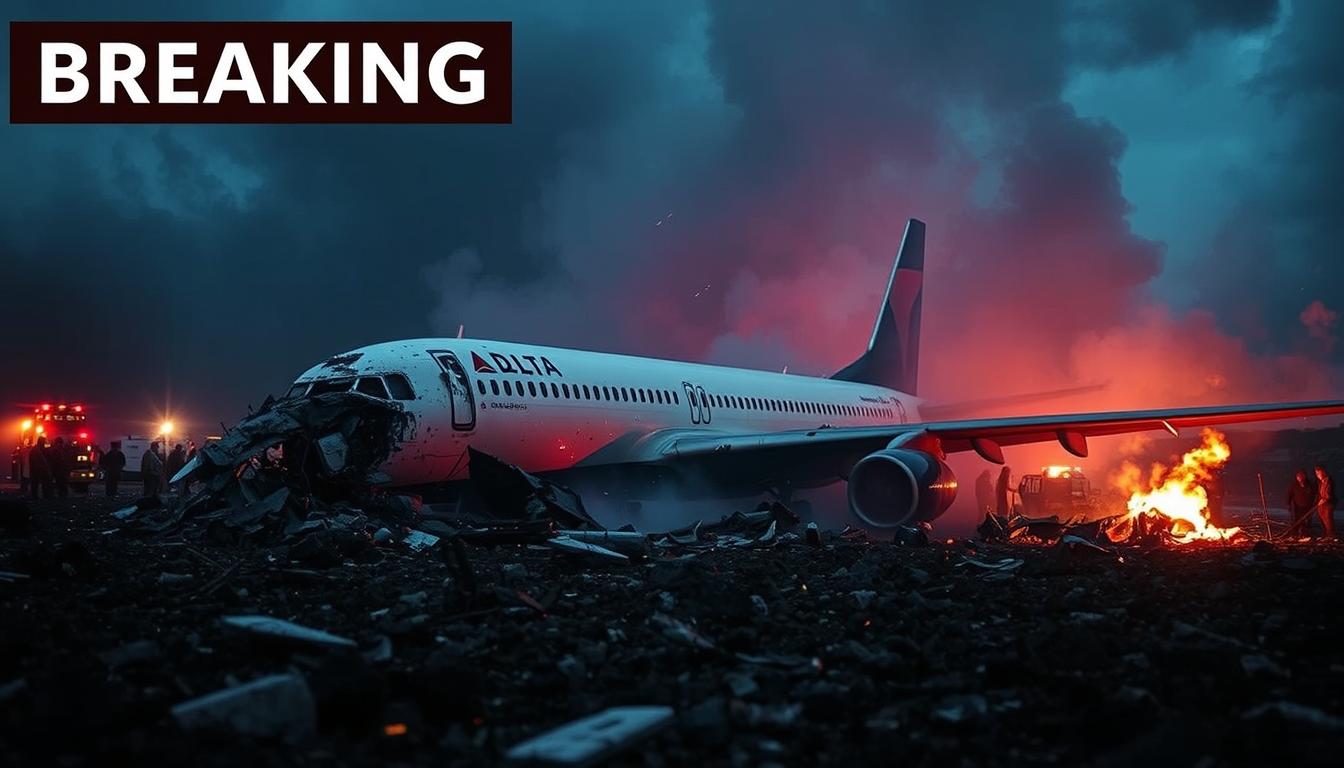What happens when a routine landing turns into a life-threatening emergency? On February 17, 2025, a flight from Minneapolis faced this terrifying reality while attempting to land at Toronto Pearson International Airport. Amid strong winds and drifting snow, the aircraft flipped over, leaving 80 people on board in a critical situation.
Despite the chaos, all passengers and crew were evacuated safely. Eighteen individuals sustained injuries, with three in critical condition. The swift emergency response played a crucial role in preventing fatalities. This incident raises pressing questions: Why did the flight flip over, and how did weather conditions contribute to the accident?
This event marks a rare occurrence at Toronto Pearson, where the last major aviation accident happened decades ago. As investigations unfold, the focus remains on understanding the factors behind this incident and ensuring the safety of future flights.
Key Takeaways
- The incident occurred during landing at Toronto Pearson International Airport on February 17, 2025.
- All 80 passengers and crew were evacuated safely, with 18 injuries reported.
- Strong winds and drifting snow were significant contributing factors.
- This is the first major aviation incident at Toronto Pearson in decades.
- An investigation is underway to determine the exact cause of the accident.
Incident Overview and Initial Reports
A routine approach to landing turned chaotic at one of North America’s busiest hubs. On February 17, 2025, a Bombardier CRJ900, operated by Endeavor Air for Delta, faced severe challenges while attempting to land at Toronto Pearson International Airport. Early reports from CNN and CBC confirmed the aircraft landed belly up, with a damaged wing, amid strong wind gusts.
Eyewitnesses described the harrowing moment when the aircraft flipped, leaving passengers suspended in their seats. “It felt like everything was upside down,” one passenger recalled. The incident occurred at a facility known for handling high volumes of traffic, causing widespread disruption to operations.
Delta and airport officials quickly released statements, pointing to strong crosswinds as a significant factor. Despite the chaos, all 80 passengers and crew were evacuated safely. However, 18 individuals sustained injuries, with three in critical condition. The swift response of emergency teams played a vital role in preventing further harm.
Questions remain about why this mishap occurred, especially given the aircraft’s solid safety record. The CRJ900, a model in service for over two decades, is typically reliable. Investigators are now focusing on the weather conditions and operational decisions during the landing.
Delta Plane Crash: Timeline and Analysis
The events leading up to the incident reveal a series of critical moments. On February 17, 2025, Delta Flight 4819 departed Minneapolis, heading for Toronto Pearson International Airport. The flight appeared routine until the final approach, when strong winds and drifting snow created hazardous conditions.
As the aircraft descended, passengers reported feeling intense turbulence. “It was like being in a washing machine,” said John Nelson, a passenger on board. Within minutes, the wind caused the aircraft to flip, leaving it belly up on the runway. The left wing was damaged, and the fuselage ended upside down.
Sequence of Events
The timeline shows that the flight was cleared to land at approximately 2:10 p.m. local time. Winds at Toronto Pearson were recorded at 32 mph, gusting to 40 mph. These conditions played a significant role in the incident.
Eyewitnesses described the moment the aircraft flipped as sudden and terrifying. “One second we were descending, the next everything was upside down,” recalled Peter Koukov, another passenger. The emergency response was swift, with crews arriving within minutes to assist.
Key Moments During the Landing
Several key moments stand out during the landing. The strong crosswinds made it difficult for the pilots to maintain control. The aircraft’s left wing struck the ground, causing it to flip. Despite the chaos, all 80 passengers and crew were evacuated safely.
Investigators are now focusing on the weather conditions and operational decisions during the final approach. The CRJ900, a model known for its reliability, faced challenges it wasn’t designed to handle in such extreme weather.
| Time | Event |
|---|---|
| 2:10 p.m. | Flight cleared to land at Toronto Pearson |
| 2:12 p.m. | Strong crosswinds reported |
| 2:15 p.m. | Aircraft flips, left wing damaged |
| 2:17 p.m. | Emergency response teams arrive |
This timeline is crucial for understanding how the incident unfolded. It highlights the challenges faced by the crew and the importance of weather awareness during critical flight phases.
Weather Conditions and Impact on the Crash
The weather played a pivotal role in the events of February 17, 2025. Strong winds and drifting snow created hazardous conditions during the flight’s approach to Toronto Pearson International Airport. These factors significantly challenged the crew’s ability to maintain control.
Strong Winds and Drifting Snow
According to Environment Canada, wind gusts reached up to 40 mph, with sustained winds at 32 mph. The snow reduced visibility and created friction on the runway. These conditions made it difficult for the aircraft to stabilize during the final descent.
Weather advisories had warned of crosswinds and slippery surfaces. These warnings were critical, as the wind direction was nearly perpendicular to the runway. This alignment increased the risk of losing control during landing.
How Weather Affected the Flight Approach
The combination of wind and snow led to a rapid change in the aircraft’s behavior. As the crew attempted to land, the strong crosswinds caused the left wing to strike the ground. This impact flipped the aircraft, leaving it belly up on the runway.
Investigators are analyzing the role of wind shear, a sudden change in wind speed or direction. This phenomenon can destabilize even the most reliable aircraft. The CRJ900, known for its safety, faced conditions it wasn’t designed to handle.
| Time | Weather Condition | Impact |
|---|---|---|
| 2:10 p.m. | Wind gusts up to 40 mph | Reduced control during descent |
| 2:12 p.m. | Drifting snow | Decreased visibility and runway friction |
| 2:15 p.m. | Crosswinds at 41 km/h | Left wing struck the ground |
This incident highlights the importance of weather awareness in aviation. International airports like Toronto Pearson must continuously update safety protocols to handle extreme conditions. Ensuring passenger safety remains the top priority.
Passenger and Crew Experiences
The moments following the unexpected landing were filled with chaos and quick thinking. Passengers and crew members found themselves in a situation that tested their resilience and composure. With the aircraft inverted on the runway, the immediate priority was ensuring everyone’s safety.
Eyewitness Accounts of the Incident
Eyewitnesses like Peter Koukov and Peter Carlson described the scene vividly. “It was surreal,” Koukov recalled. “One moment we were descending, and the next, everything was upside down.” Passengers quickly unbuckled their seatbelts, some jumping from the inverted doorways onto the snow-covered runway.
“The snow made it harder to move, but we knew we had to get out fast,” said Carlson. “People were helping each other, even though everyone was scared.”
Evacuation and Emergency Response
The emergency response was swift and efficient. Crews arrived within minutes, assisting injured passengers off the runway despite the snowy and perilous conditions. Eighteen individuals were transported to hospitals, with three in critical condition. However, all 80 passengers and crew were evacuated safely.
The weather played a significant role in the evacuation. With temperatures at 16.5°F and wind gusts up to 40 mph, the conditions were challenging. Yet, the coordination between emergency services and airport personnel ensured a smooth operation.
| Aspect | Details |
|---|---|
| Passengers on Board | 80 |
| Injuries Reported | 18 |
| Critical Injuries | 3 |
| Evacuation Time | Within 10 minutes |
This incident highlights the importance of preparedness and teamwork in emergencies. The quick actions of both passengers and responders ensured that a potentially tragic event ended with everyone safe.
Delta Air Lines Safety Record and Responses
How safe are Delta Air Lines? This question has been at the forefront of discussions following the recent incident. With a long-standing reputation for safety, Delta has consistently prioritized the well-being of its passengers and crew. However, the events at Toronto Pearson International Airport have sparked conversations about its practices and protocols.
Assessment of Delta’s Safety History
Delta Air Lines has maintained a strong safety record over the years. The airline has implemented rigorous training programs and advanced aviation technologies to ensure passenger safety. Despite isolated incidents, Delta’s commitment to safety remains unwavering.
According to historical data, the airline has not experienced a fatal accident in over a decade. This record is a testament to its dedication to maintaining high standards. However, the recent incident involving the CRJ900 aircraft has raised questions about how environmental factors are managed during critical flight phases.
Official Airline Statements and Updates
Following the incident, Delta issued a statement confirming that all passengers and crew were safely evacuated, with no fatalities reported. The airline emphasized its focus on supporting those affected and cooperating fully with the investigation.
“Our top priority is the safety and well-being of our passengers and crew. We are committed to understanding the factors that led to this incident and ensuring it does not happen again.”
Deborah Flint, CEO of Toronto Pearson International Airport, and Fire Chief Todd Aitken also commended the swift response of emergency teams. Their efforts played a crucial role in minimizing injuries and ensuring a safe evacuation.
Delta’s immediate response included deploying an incident response team and holding press conferences to provide updates. The airline’s transparency has been praised, though public perception remains a concern. Moving forward, Delta may adopt additional measures to address extreme weather conditions and enhance training protocols.
Investigative Efforts and Preliminary Findings
Investigators are working tirelessly to uncover the truth behind the incident. The Transportation Safety Board of Canada, alongside the U.S. National Transportation Safety Board, has launched a full probe. Their goal is to determine how severe weather and potential control system issues contributed to the event.
Initial Inquiries by Aviation Authorities
Immediately after the incident, both Canadian and U.S. teams began collecting evidence. Flight recordings, weather logs, and eyewitness testimonies are being scrutinized. Deborah Flint, CEO of Toronto Pearson International Airport, emphasized the importance of transparency in the process.
Authorities are focusing on the aircraft’s performance during landing. They are also reviewing air traffic communications to identify any missteps. This comprehensive approach ensures no detail is overlooked.
Key Factors Under Investigation
Preliminary findings suggest multiple factors played a role. Severe wind gusts and drifting snow created hazardous conditions. Investigators are also exploring potential mechanical anomalies that may have affected the aircraft’s stability.
“Our priority is to understand what happened and prevent future incidents,” said a spokesperson for the Transportation Safety Board.
The investigation is expected to take several months. However, early insights highlight the need for enhanced safety protocols, especially during extreme weather. Restoring public confidence in safety remains a top priority.
Aviation Experts Weigh In
Aviation experts have stepped forward to analyze the mechanics behind the incident. Their insights shed light on how extreme weather and specific flight dynamics contributed to the unusual outcome. The focus remains on understanding why the aircraft flipped and how the crew managed the situation.
Industry Expert Opinions
Experts attribute the flip to a combination of high wind speeds and abrupt changes in the aircraft’s flight path. According to one aviation analyst, “The crosswinds created a destabilizing force that the pilots couldn’t counteract in time.” This aligns with the testimony of the fire chief, who noted the challenging conditions during the emergency response.
Another critical factor was the crew’s response. Effective crew resource management played a vital role in ensuring a safe evacuation. “The crew’s training and quick decision-making minimized injuries,” said a safety consultant. This highlights the importance of preparedness in emergency situations.
The broader implications for aviation safety are also under discussion. Experts suggest that regulatory policies may need updates to address extreme weather conditions more effectively. “This incident serves as a reminder that even experienced pilots face unpredictable challenges,” noted an industry leader.
| Factor | Expert Insight |
|---|---|
| Wind Speeds | High gusts destabilized the aircraft during landing. |
| Crew Response | Effective resource management ensured a safe evacuation. |
| Regulatory Policies | Updates may be needed to address extreme weather risks. |
These insights provide a clearer picture of the incident and its implications. As investigations continue, the aviation community remains committed to enhancing safety protocols for future flights.
Historical Context of Delta and Aviation Crashes
Understanding the history of aviation incidents helps put recent events into perspective. Over the decades, the industry has faced numerous challenges, but each incident has contributed to improved safety measures. This latest event at Toronto Pearson International Airport is no exception.
When Did the Last Delta Plane Crash Occur?
The last significant incident involving Delta occurred in 1996, when Flight 1288 experienced an engine failure, resulting in two fatalities. Since then, Delta has maintained a strong safety record, with no major crashes until this year. This highlights the rarity of such events and the airline’s commitment to safety.
Comparison to Other Major Incidents
This incident draws parallels to the 2005 Air France crash at Toronto Pearson, where all passengers survived despite severe weather conditions. Both events underscore the importance of crew training and emergency preparedness. However, the 2005 incident resulted in no injuries, while the recent event left 18 people injured, three critically.
Another notable comparison is the 1985 Delta Flight 191 crash, which claimed 134 lives. This tragedy led to significant changes in aviation safety protocols, including improved weather monitoring and pilot training. Today, such measures have reduced the likelihood of similar outcomes.
“Every incident teaches us something new. The goal is to ensure that history doesn’t repeat itself,” said an aviation safety expert.
Over the years, the industry has made strides in reducing injuries and fatalities. Enhanced evacuation procedures, better communication systems, and advanced aircraft technology have all played a role. Yet, incidents like this remind us that there’s always room for improvement.
The human toll of these events extends beyond physical injuries. Passengers and crew often face lasting psychological impacts, and public trust in air travel can be shaken. Addressing these concerns is crucial for maintaining confidence in the industry.
As investigations continue, the lessons learned from past incidents will inform future safety practices. The goal is not just to prevent crashes but to ensure that every passenger and crew member can travel with peace of mind.
Toronto Pearson International Airport: Response and Aftermath
The response to the incident at Toronto Pearson International Airport was swift and coordinated. Multiple runways were temporarily closed to manage the situation, causing significant disruptions to operations. Emergency services, including air ambulance helicopters and ground fire crews, were mobilized immediately to assist injured passengers and secure the scene.

Emergency Services and Airport Disruptions
Fire Chief Todd Aitken described the challenges faced during the response. “The conditions were extremely difficult due to the snow and wind, but our teams worked efficiently to ensure everyone’s safety,” he stated. Three helicopters and two critical care ambulances were dispatched to transport the injured to nearby hospitals.
Toronto Pearson CEO Deborah Flint emphasized the importance of teamwork. “Our priority was to clear the scene and resume operations as quickly as possible,” she said. Despite the chaos, partial operations resumed within three hours, minimizing delays for other flights.
Steps Taken Post-Incident
Following the incident, airport officials took several steps to restore normalcy. Runways were inspected and cleared of debris, while additional staff were deployed to manage passenger flow. The airport also issued updates to travelers, advising them of potential delays.
| Aspect | Details |
|---|---|
| Runways Closed | 2 |
| Emergency Vehicles | 3 helicopters, 2 ambulances |
| Response Time | Within 10 minutes |
| Partial Operations Resumed | 3 hours post-incident |
The efficiency of the airport’s emergency protocols was evident, even as the aftermath required extensive follow-up investigations and repairs. This incident serves as a reminder of the importance of preparedness in handling unexpected events.
Conclusion
The recent incident at Toronto Pearson International Airport has raised critical questions about aviation safety and weather preparedness. Strong winds and drifting snow created hazardous conditions, challenging the crew’s ability to maintain control. Despite these challenges, the swift response from emergency teams ensured all passengers and crew were evacuated safely.
Statements from Delta and airport authorities highlight the importance of thorough investigations. Understanding the factors behind this event is crucial to preventing similar occurrences in the future. Aviation experts emphasize the need for enhanced protocols, especially during extreme weather.
This incident serves as a reminder of the resilience of the aviation industry. Ongoing efforts by authorities to improve safety measures are essential. As investigations continue, staying informed about updates will provide further clarity on this event and its implications for future policies.

